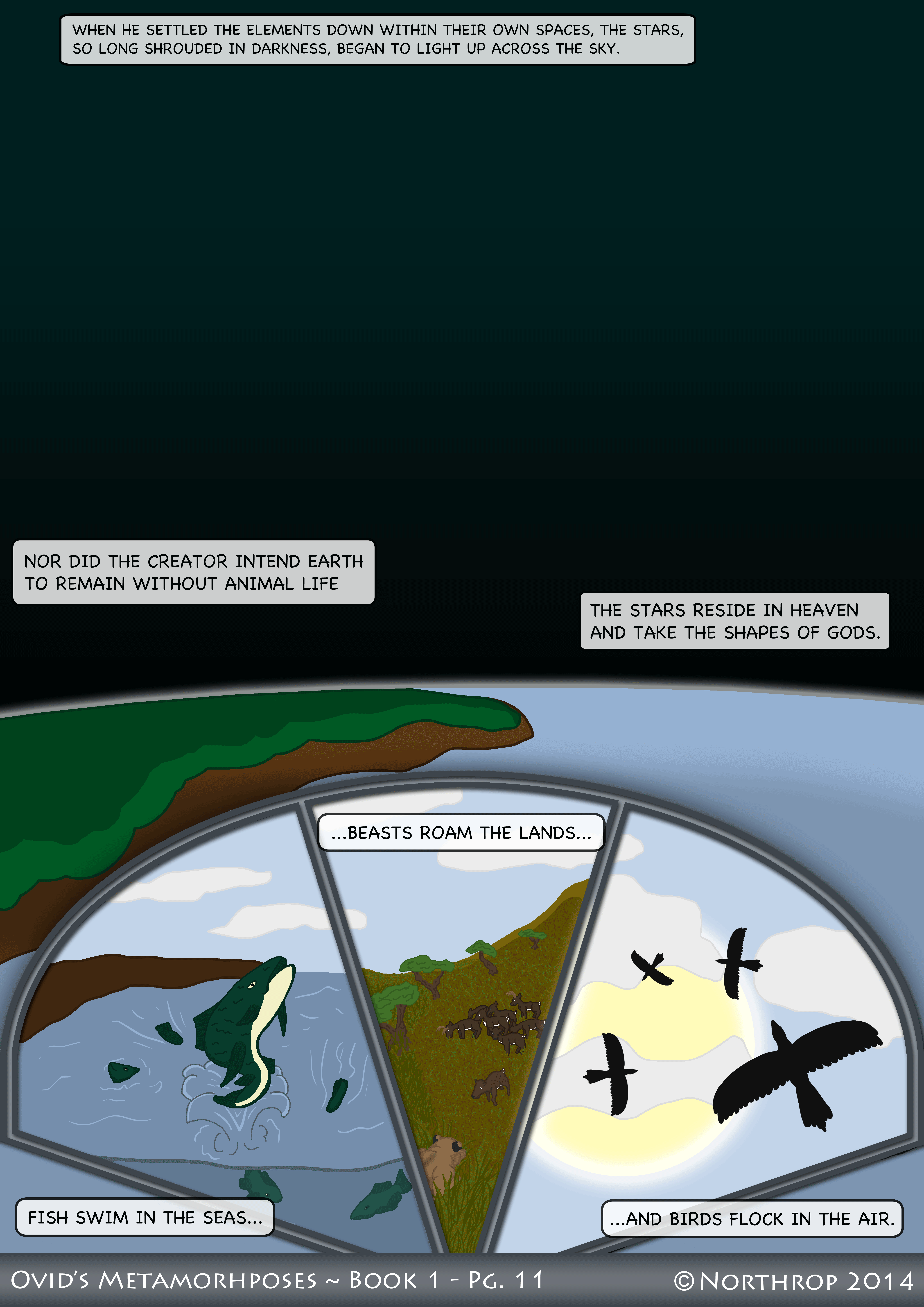Met. 1.69-75 – The Zoogony
VIX ITA LIMITIBUS DISSAEPSERAT OMNIA CERTIS,
CUM QUAE PRESSA DIU FUERANT CALIGINE CAECA
SIDERA COEPERUNT TOTO EFFERUESCERE CAELO.
NEU REGIO FORET ULLA SUIS ANIMALIBUS ORBA,
ASTRA TENENT CAELESTE SOLUM FORMAQUE DEORUM,
CESSERUNT NITIDIS HABITANDAE PISCIBUS UNDAE,
TERRA FERAS CEPIT, VOLUCRES AGITABILIS AER.
SCARCELY HAD HE SO DIVIDED ALL THINGS INTO CERTAIN BOUNDARIES
WHEN THE STARS, LONG SUPPRESSED BY THE BLIND DARKNESS,
BEGAN TO LIGHT UP ACROSS THE SKY.
LEST ANY REGION OF THE GLOBE WOULD BE WITHOUT ITS ANIMALS,
THE STARS HOLD THE HEAVENLY GROUND, AND TAKE THE FORMS OF GODS,
THEY LET THE REALM OF WATER TO THE SHIMMERING FISHES,
THE LAND TAKES THE BEASTS, AND THE AIR, THE AGILE BIRDS.
My, we are getting detailed now! The cosmic creation has already wrought the Earth, and seas and sky; now it is time to populate them. This is the zoogony, or ‘creation of the animals’. The entertwining of the stars and animals in the last three lines shows that the astral bodies are being equated with the critters that scurry across the surface of the Earth. This is not really Ovid’s idea – Stoic philosophy argued the stars were sentient, as seen for example in Balbus’ exposition from Cicero’s On the Nature of the Gods – but he adds the beautiful touch of the stars twinkling into view as the darkness of Chaos recedes. This darkness is one of the features drawn from the older, Greek incarnation of Chaos found in Hesiod. Ovid’s inclusion of the stars here places his creation story in a line of scholarship that stretches back to Hesiod himself. Early poets, whose writings blended art and magic with serious contemporary science, were quite interested in stars and constellations. Hesiod wrote a Phaenomena (now gone save for a few fragments), a poem that told the origin stories of constellations and other astral bodies. Constellations, in Greek and Roman mythology, are often humans and gods that have been translated to heaven. Many of the stories in Phaenomena are stories of nymphs and heroes transformed after some marvelous brush with the divine; exactly the type of material that characterises the body of the Metamorphoses. Therefore, the connection between the stars and life on Earth makes sense, and its placement in the beginning of the Metamorphoses doubly so. Phaenomena were popular among Alexandrian and Hellenistic writers, who took an interest in erudite and arcane learning from around the known world, as well as scientific concepts that could be illustrated with poetic narrative. Ovid himself took on a similar project in a different poem, composed simulataneously to the Metamorphoses: his Fasti is dedicated to the Roman calendar, recently reformed in Ovid’s childhood by Julius Caesar, into the solar calendar used throughout much of the world today. The Fasti reach back through the tradition of Phaenomena and other aetiological poems to Hesiod and the beginning of mythical science. That this connection is made by Ovid is clear from the first book of the Fasti. One of Hesiod’s most famous poems is titled “Works and Days” (Opera et Dies in Latin). In Fasti 1, Ovid actually ‘interviews’ Chaos, now transformed after the cosmogony into the two-faced god Janus, who addresses the Roman poet: “teach fearlessly, oh poet who works on days…” (disce metu posito, vates operose dierum). Puns aside, between the Metamorphoses and the Fasti (which undoubtedly were meant to be read together to a certain extent), I think Hesiod would be proud of Ovid’s cosmological poetic accomplishments. For more on Ovid’s relationship with Hesiod, I highly recommend Ioannis Ziogas’ book, Ovid and Hesiod (2013). K Sara Myers also has a fantastic, if highly technical book on Ovid’s use of aetiology in his cosmogonic and cosmological narratives: Ovid’s Cause (1994). Her second chapter is particularly relevant to our discussion of Ovid’s ‘remythologisation’ of scientific thought in his poetry.
The animals just spontaneously generate on the Earth. I’ve been a bit naughty in my comic version and assigned agency to the creator god for life on Earth. In truth, if you look at the Latin (and my more literal translation) they just kinda appear. Spontaneous generation of animal life was actually a common notion before the advent of modern science. Life was thought to be the product of varying degrees of heat an moisture. People thought maggots were grown from rotting meat, and didn’t necessarily observe that they came from flies’ eggs. In poetry, this spontaneous generation is applied to a wide variety of creatures. Vergil’s Georgics famously tell how to grow bees from the carcass of a cow (a process called bugonia). Being an author of tales of transformation, Ovid is very keen on this theme. Vergil was probably just one of his models, and as K Sara Myers (1994: 43-4) points out, we find the theory also in Lucretius’ On the Nature of Things, and Diodorus Siculus’ Historical Library, both of which were big influences on Ovid. In the Metamorphoses, spontaneous generation is a concept to watch, so stay tuned!
Finally, I am proud of my latest .gif creation! The animation is still bare-bones, but I’m learning. Hopefully I’ll get more detailed as the comic progresses…

Discussion ¬